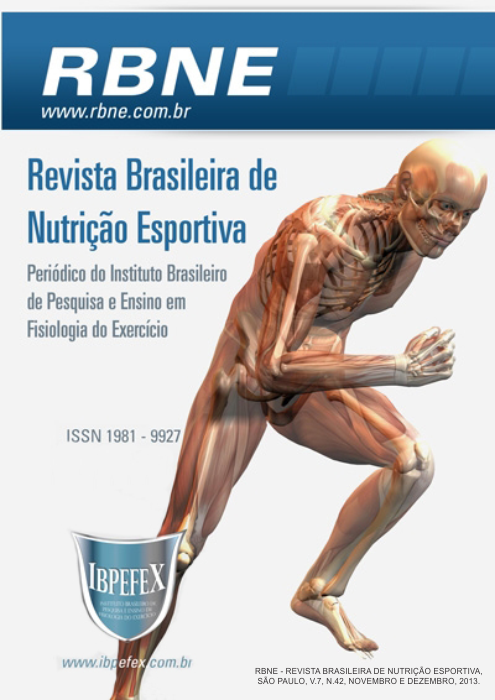Nutrition and periodization for strength training: a case study
Abstract
The objective of this study was to observe the body composition changes induced by 8 weeks of a nutritional program associated a strength training planning in a woman (age: 37 years; body mass: 52 kg, height: 1.60 m). The training program lasted eight weeks and consists of two mesocycles (M1 and M2). In the first mesocycle the diet plan was of 1889 calories (255.2g of carbohydrates, 84.69g of protein and 61.7g of total fat). At M2 it increased to 2380 calories (347.1g carbohydrate, 97.4g protein and 71.4g of total fat). Total body mass increased 1 kg and body fat reduced 2.2 kg. The free fat mass increases 2.6 kg post M1 and 0.5kg post M2; The %fat decreased 5% post M1 and post M2 increased 0.7%; The training loads of M2 were significantly (p<0.05) higher than those of M1. We conclude that the training program applied, together with the dietary plan performed induced an increase of free fat mass and a reduction in the %fat in the volunteer studied. However, correlations between the training loads and body composition changes are not yet well established in the literature. We propose that future studies with different experimental models aim at observe such relationships.
References
-Fluck, M.; H. Hoppeler. Molecular basis of skeletal muscle plasticity-from gene to form and function. Rev Physiol Biochem Pharmacol. Vol. 146. p.159-216. 2003.
-Ide, B. N.L.; Lopes,C. R; Sarraipa, M. F. Fisiologia do treinamento esportivo. Vol.1. 288p. 2010.
-Jackson, A. S.;Pollock, M. L. Generalized equations for predicting body density of women. Med Sci Sports Exerc. Vol.12. Núm. 3. p. 175-181. 1980.
-Kraemer, W. J.; Häkkinen, K. Strength Training for Sport: Olympic Handbook of Sports Medicine: Wiley-Blackwell. 2002.
-Siri, W. E. Body composition from fluid spaces and density: analysis of methods. 1961. Nutrition. Vol. 9. Núm. 5. p. 480-491.1993.
-Zierath, J. R.; Hawley,J. A. Skeletal muscle fiber type: influence on contractile and metabolic properties. PLoS Biol. Vol. 2. Núm.10. p. e348. 2004.
Authors who publish in this journal agree to the following terms:
- Authors retain the copyright and grant the journal the right of first publication, with work simultaneously licensed under the Creative Commons Attribution License BY-NC which allows the sharing of the work with acknowledgment of the authorship of the work and initial publication in this journal.
- Authors are authorized to enter into additional contracts separately for non-exclusive distribution of the version of the work published in this journal (eg, publishing in institutional repository or book chapter), with acknowledgment of authorship and initial publication in this journal.
- Authors are allowed and encouraged to post and distribute their work online (eg, in institutional repositories or on their personal page) at any point before or during the editorial process, as this can bring about productive change as well as increase impact and impact. citation of published work (See The Effect of Free Access).






